By encouraging advertisers to switch to Performance Max campaigns, Google promises an increase in conversion rates by combining advertising resources. It’s possible to get such a result, but only with the right approach to campaign optimization. Learn more about the advantages and disadvantages of this new type of advertising and the peculiarities of setting up and optimizing Performance Max. A PPC specialist at Ringostat shares his recommendations.
What is Performance Max
Performance Max is a type of advertising that can be placed simultaneously on all possible Google advertising platforms. For example, ads within a campaign can be shown not only in organic search or contextual media networks, but also on YouTube, Gmail, Google maps, and the like. The advertiser allocates one overall budget for all of this, which is allocated automatically among the various channels using smart algorithms that constantly monitor performance.
Pros and cons of Performance Max
Advantages
- Full automation. Machine learning algorithms take many parameters into account, so campaigns tend to produce really good results. However, an automated campaign is almost impossible to influence — and this is one of the significant disadvantages, which I’ll discuss in more detail next.
- Combining all of Google’s channels. A PPC specialist can set up just one campaign, and the ads will be shown on all promotion channels. This saves a lot of time when launching activities.
- Coverage of all the sites of the Google ecosystem. As a result, interaction with the user takes place at all stages of the sales funnel.
- Aiming specifically at conversions, as opposed to other types of campaigns that focus on reaching or building brand awareness. For example, in the case of Bumper ads, which are splash ads. It’s also possible to scale product promotion through Google Ads.
- Positive impact and complement search campaigns.
Disadvantages
- It is not possible to evaluate the effectiveness of individual channels and control the search queries for which ads are shown. I already mentioned: artificial intelligence itself collects and analyzes various signals, eventually making a decision on your ads on its own. And the statistics are quite limited.
- Low efficiency with volumes of data insufficient for optimization. If your account cannot boast of the number of conversions, probably Performance Max will not bring you good results. This type of campaign only provides automatic bidding strategies, and they require at least 15 conversions in 30 days. And as practice shows, the more the better.
- The need for significant budgets. Since Performance Max includes all the possible promotion channels of Google, without a sufficient amount of money the campaign will not work.
- Prolonged training and unstable performance during this time. Usually, Google’s artificial intelligence training takes about two weeks, but Performance Max requires more time. In our experience, the campaign stabilized after a month of uninterrupted work and began to bring noticeable results in the third month of promotion.
- The risk of spam conversions on lead generation, especially in the first stages of the launch. The reason, again, is the inability to manually adjust targeting, keywords, etc.
In general, Performance Max is suitable for most advertisers: ecommerce, B2B, B2C, SaaS. The only exception is app advertising, which requires the creation of a Universal app campaign.
By the way, for B2B Performance Max is a real godsend. Because previously only e-commerce had a trade campaign tool, other niches had nothing like it. In addition, smart trading companies are now part of Performance Max.
What to keep in mind before and during Performance Max optimization
To begin with, consider the features that are worth paying attention to at the stage of advertising.
Take into account all the targeted actions of the users of the site
Most advertisers use only certain data for training campaigns. For example, only about filling out a form on a page if you’re talking about lead generation projects. Or only about transactions, if we’re talking about e-commerce. However, this is not enough.
For example, a potential customer doesn’t want to buy a product right away and would prefer to first ask the sales rep about product features, find out about a discount or place an individual order. That’s why he doesn’t add the item to the cart on the site, but calls. But Google won’t be able to track this purchase, because no online conversion has taken place. So the system won’t take into account the data on such a transaction at the training stage. And if a certain advertising campaign brings mainly such “phone” orders, the system will mistakenly consider it ineffective. As a result, you may lose the channel that actually brought you sales.
To avoid such blind spots, you should use call tracking, a tool for tracking the advertising source of phone calls. With call tracking, you’ll know exactly what sources, channels, campaigns, and keywords brought users to the site who ended up calling. The data on the advertising source of the call is collected by call tracking in a report:

But don’t limit yourself to the reports provided by the call-tracking platform. It is also worth transferring data on calls to Google Ads — this, by the way, will help solve the problem of insufficient numbers of conversions for the training of an advertising system. Especially since phone calls are still the main, or at least significant, source of customer conversions. By transferring call data to Google Ads, you’ll increase the number of conversions needed to train and optimize your campaigns.
For Performance Max, it’s not just the quantity, but also the quality of conversions that matters. And call tracking data, again, comes in handy. The fact is that the system designates particularly valuable phone calls as “targeted.” These are, for example, conversations with a potential customer that lasted quite a long time. Transmit Performance Max data is not about all calls without exception, but only about the target. The system will learn from the most successful conversions.
When creating companies, add audience signals
Audience signals are data about the interests and actions of potential customers, which together define a pattern of behavior. When Google determines which users to show ads to, it looks to this pattern.
You can add signals at the campaign creation stage. The settings are in the “Object Groups” section. Include in signals, in particular, special segments, which can be created in the Audience Manager.
You can add data about your remarketing audiences, specify detailed interests and demographics of your potential buyers. And don’t forget to exclude your current customers if it’s no longer appropriate to show them ads.
Give the system as much information as possible to create ads
In each object group, try to fill in all possible content elements: headlines, long titles, descriptions, images, and videos.
At Ringostat, for example, it’s not easy for us to create creatives, because our product cannot be seen or “touched. But we still try to create and add as many visuals to our ads as possible. For example, we show happy people who use telephony 🙂 And we also add text about what benefits the user will get with our products. And we find out about the needs and expectations of users directly by communicating with them.
Direct traffic only to specific URLs
The Performance Max setting allows you to direct traffic to relevant pages on the site. But it’s worth thinking about which URLs to add to exceptions. For example, pages with privacy policies, reviews, etc.
Also think about how to create a relevant site group under the relevant pages.
For example, in the case of Ringostat, if you let the system choose the target URL at its own discretion, ads can be shown for each of our seven products. Therefore, all ads should logically match all of the landing pages.
Setting up and running Performance Max
I will briefly describe the basic steps for creating and setting up a campaign.
Step 1: Create a Performance Max ad campaign
In your Google Ads account, click “+ New Campaign.

Among the proposed objectives, choose the most appropriate for your business: sales, potential customers, and the like.
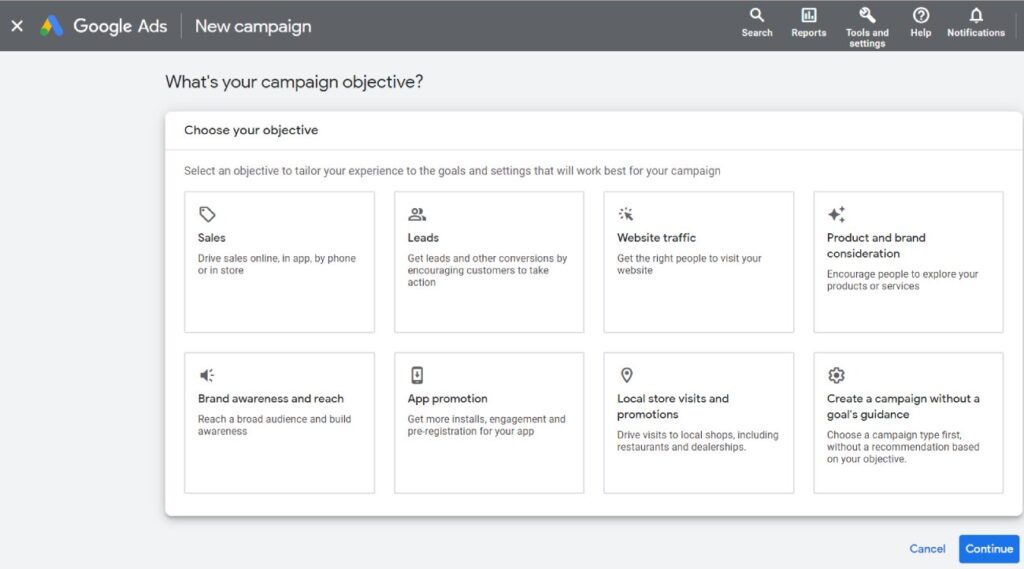
Google will also suggest selecting the conversions to be used for training — we mentioned above that, for example, for the e-commerce niche, in addition to “Transactions” you should add conversions by calls, messages, and the like.
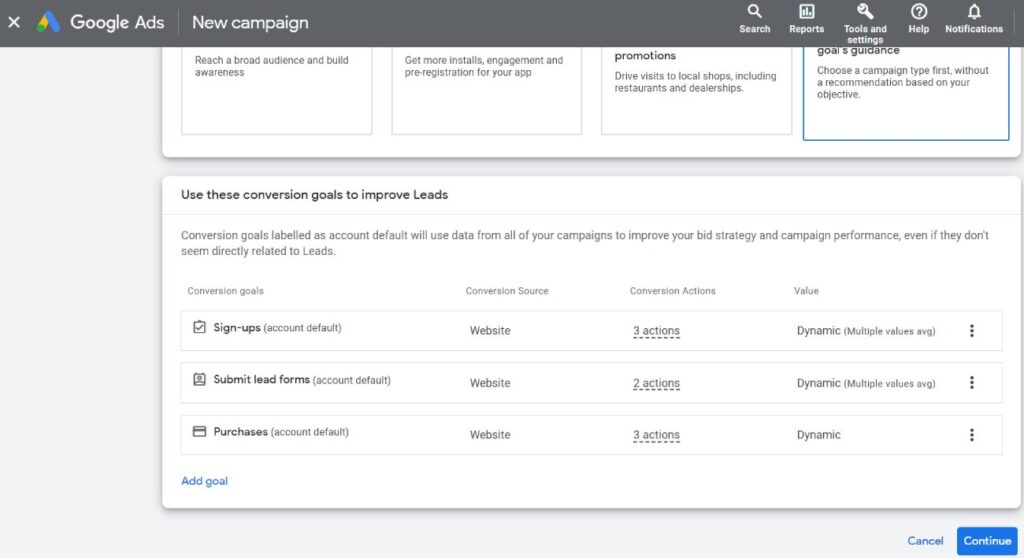
Select the type of campaign — “Performance Max”.
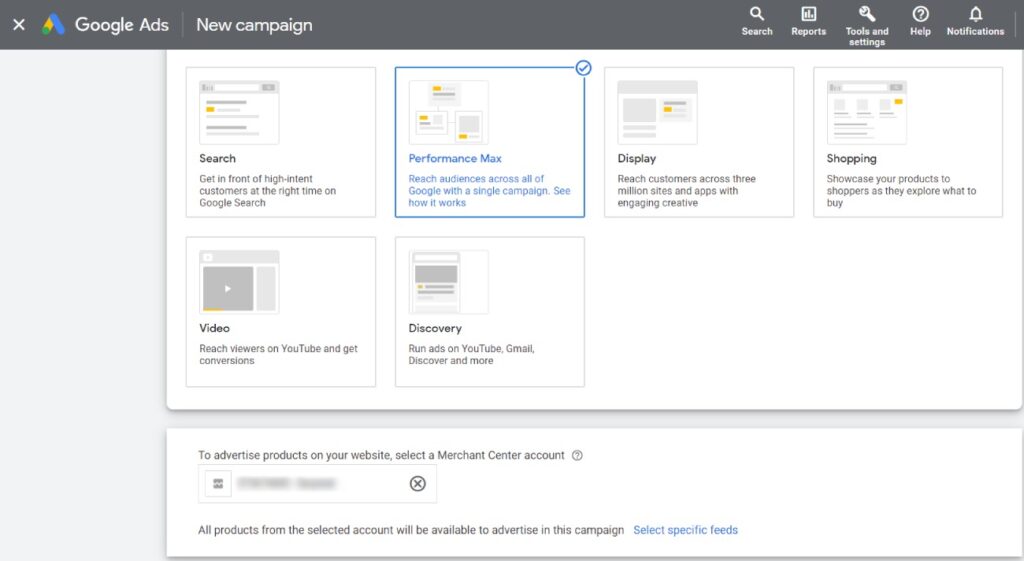
The next setting is important for online stores with links between Google Ads accounts and the Google Merchant Center — here you can add a feed and country of sale.
Specify the name of the campaigns, which you can then easily find and distinguish from the rest in the advertising cabinet.
Step 2: Setting up Performance Max campaigns
Select the “Conversions” or “Conversion Value” rate assignment type and set the appropriate target price per conversion or target ROI.
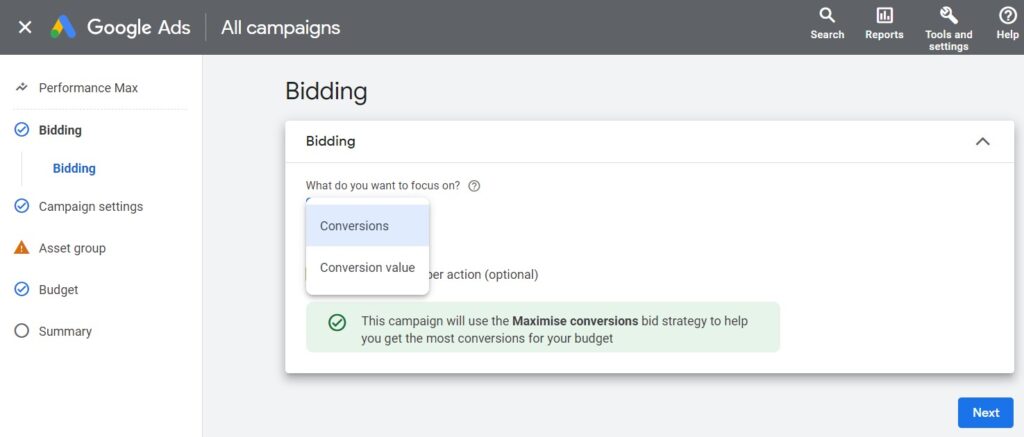
Select the location where the advertisement is to be displayed. Specify the target location of the impressions, and exclude those cities and areas where selling is not currently possible or is not feasible.
Also, Specify the languages in which you are promoting your products/services.
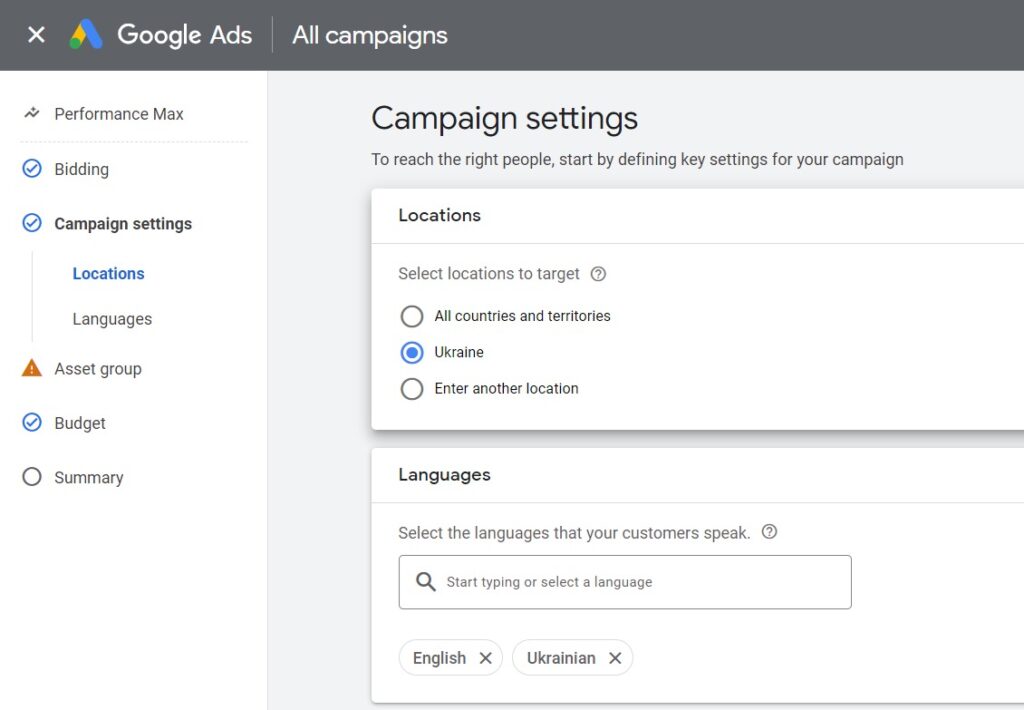
In the Advanced Settings section, you can set the start and end date for displaying ads. This is useful if Performance Max must run before a specific event, such as a holiday or promotion.
Click “Advanced Settings” — where you can specify site pages that will not participate in the ad campaign, such as service pages. I mentioned it above – no traffic will be sent to such pages.
In “Advanced Settings” you can add UTM markup to track the source of traffic and analyze ad effectiveness.
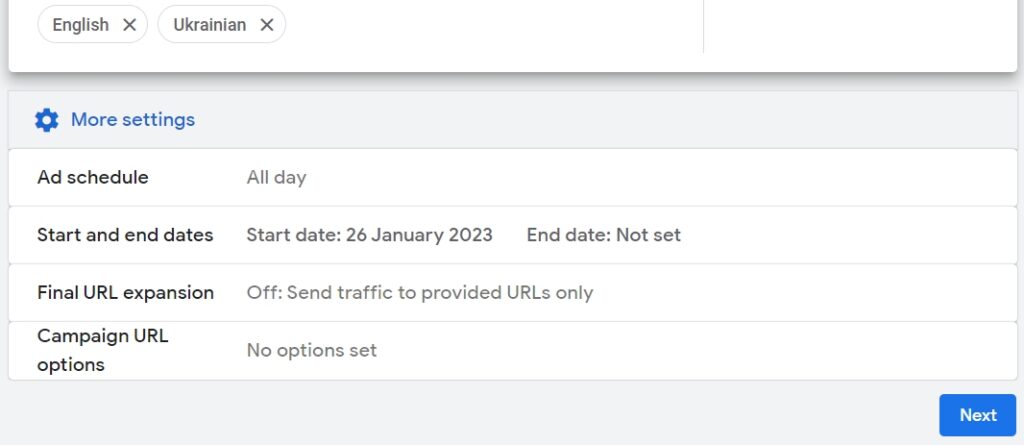
Step 3: Create Performance Max campaign ads for the Performance Max campaign
Creating ads is a separate interesting and important topic that requires a full-fledged article. So I’m not going to detail Google’s requirements and recommendations for headline and description texts, creatives, and videos, but just briefly describe the ad creation algorithm.
Add the address of the page for which you’re creating the ad. Also add at least two images of ad creatives — square and horizontal.
Upload your company logo. You can add a video, and if you don’t have one ready, Google will try to put together some sort of presentation based on the images and text you added earlier.
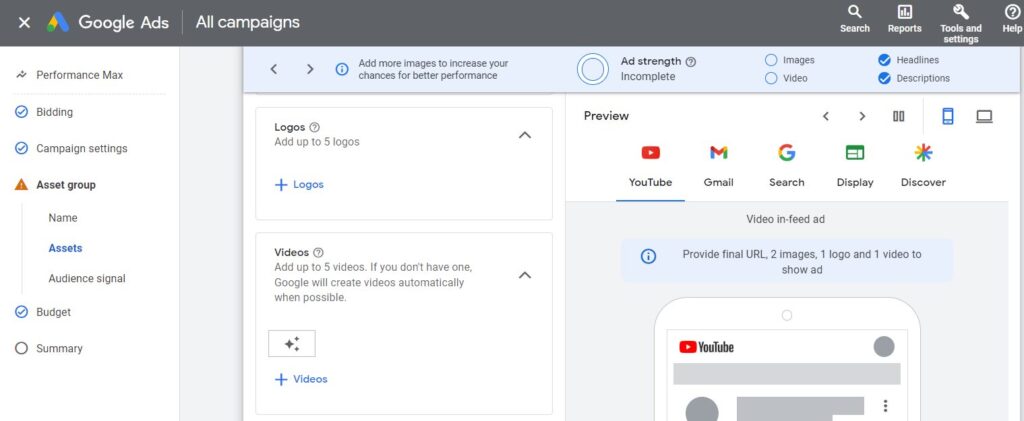
Add to your ad all the possible titles and descriptions. The system itself will combine them, choosing the most successful combinations. I’ll tell you a little more about this.

Specify the name of the company/brand/store, add a link to the site, select a call to action, and add all possible object types (structured descriptions, clarifications, prices, etc.), and the displayed path.
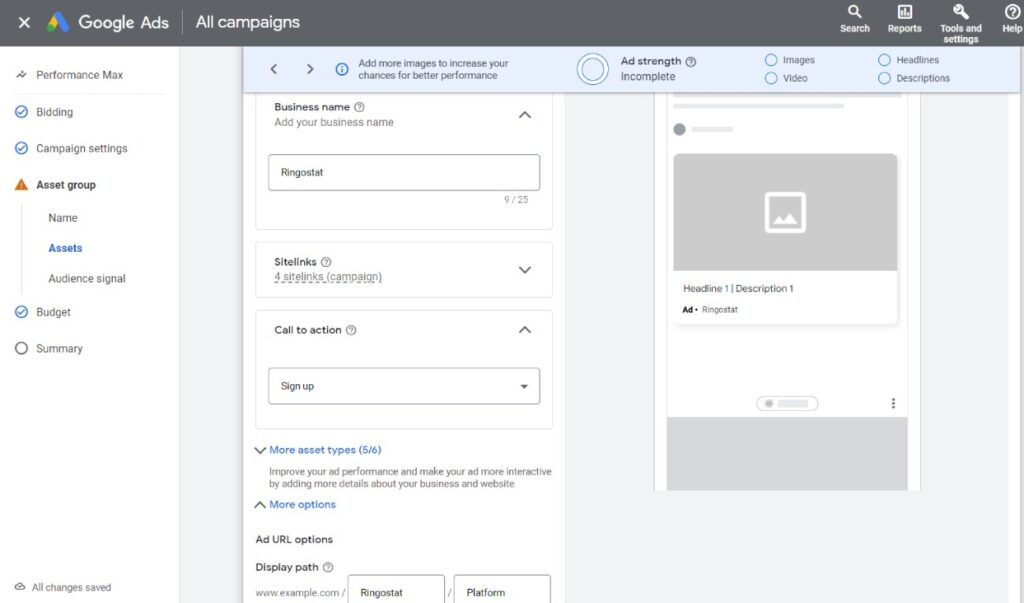
Add audience cues.
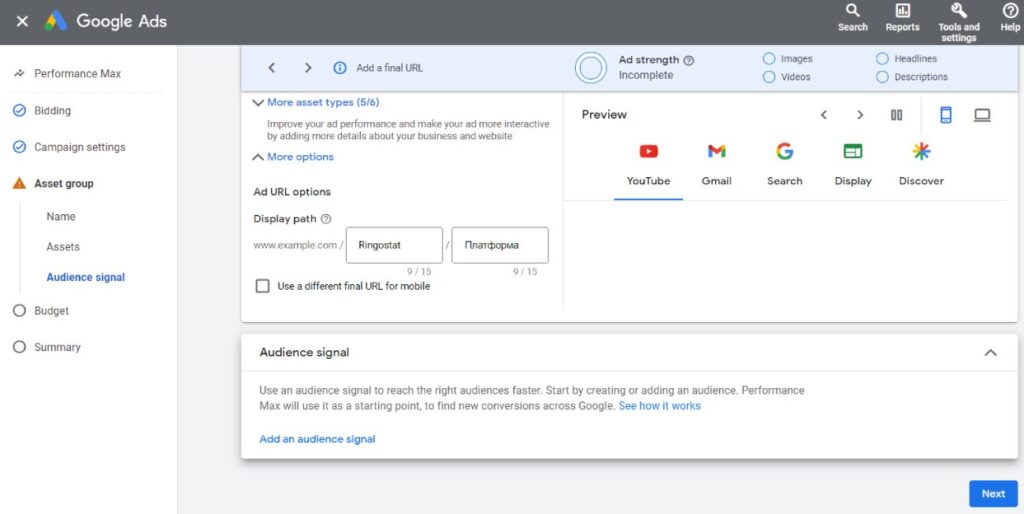
And lastly, specify the campaign budget.
Once you’ve completed all the steps, click “Publish”. Wait about 24 hours before the group of items goes through moderation.
Optimizing Performance Max campaigns
So, you’ve prepared well for the launch and set up the campaigns correctly, and the system has had enough time to learn and collect data. You can move on to the next stage — campaign optimization. Let’s look at possible problems and ways to solve them.
What to do in case of conflict between Performance Max and brand campaigns
Performance Max is a great addition to keyword-based search campaigns to reach more users and get more conversions across all Google channels. However, there have already been complaints from PPC experts about branded traffic being “pulled” by Performance Max campaigns. We at Ringostat have been spared this problem. I’ll tell you more later.
Here’s what Google’s help says about this: if a user’s search query matches an account’s native keyword, regardless of the type of match, it’s the search campaign that will take priority. This means that your branded search campaign will be “more important” than your top-performing campaign. With a few exceptions:

So, if the launch of Performance Max has “messed up” the results of branded campaigns, analyze their settings and optimize according to Google’s requirements. Also assess the percentage of branded campaign impressions in the search engine during the relevant time periods – before and after the launch of Performance Max. If it’s stable, the problem isn’t the new campaign.
What to do if the company brings a lot of spam leads
Analyze your competitors — this will help you understand whether the advertisement is seen by your target audience. The data you need is available in the Auction Statistics section.
If you see advertisers among your competitors that are remotely related to your niche, it’s likely that your campaign is optimized based on the wrong signals. In that case, it’s worth revisiting your audience signals, analyzing ads, banners, videos. And optimize that content.
Re-read the text of the ads and make sure that the ads do not distort the essence of your product or service, and users really understand what it’s about. Audio recordings of conversations with non-target audience members will also come in handy — they are available to users of virtual telephony or call-tracking. Listen to see if people say things like, “I thought you were advertising A, not B.” This will help clarify text, add or replace keywords, and refine banners.
Pay special attention to the headings
Search ads are generated based on headlines. That said, all five of the headlines you create can be “shuffled” and linked together in various combinations. Therefore, at least four of them should contain information about your products or services, as well as include targeted keywords.
Because of the character limit, only two headlines usually make it into a search ad. And if it’s too abstract, there’s a risk that users will misunderstand the meaning of the ad.
Analyze the effectiveness of objects and their combinations
You can start this analysis as soon as the system training is complete and all objects in the Performance Max campaign have a certain status. You should pay attention to this issue at least once or twice a month.
The data for analysis is available in the “Object Groups” section, where you should click on the “View Details” tab.
What to pay attention to? First, to objects with a low quality score to edit texts, images, videos right away. Secondly, on combinations of objects to understand which of them the system shows users most often.
Analyze placements and add potentially irrelevant ones to exceptions
You can see the data on the locations of your ads in the “Reports” section.
At the time of writing, the system only allows you to analyze the number of impressions. But even that is better than nothing. If you notice that a significant portion of displays are gaming or children’s sites, add these places of placement to exceptions at the account level.
I also suggest turning off ad impressions in apps.
At the time of writing, the system only allows you to analyze the number of impressions. But even this is better than nothing. If you notice that a significant portion of displays are gaming or children’s sites, add these sites to exceptions at the account level.
I also suggest turning off ad impressions in apps. This setting is available under Tools & Options under the Content Eligibility tab.
Bonus: reinforcement of other types of campaigns thanks to Performance Max
We noticed that the maximum efficiency campaigns had a positive impact on our search campaigns, both brand and product. They performed better: the overall number and quality of leads increased.
You can evaluate the impact of the Performance Max campaign on other campaigns by looking at the conversions from impressions. All you need to do is set up conversion tracking using the Google Ads tag.
Bonus: Strengthen other types of campaigns with Performance Max
We noticed that Performance Max campaigns had a positive impact on our search campaigns, both brand and product. They performed better: the overall number and quality of leads increased.
You can evaluate the impact of the Performance Max campaign on other campaigns thanks to conversions from impressions. All you need to do is set up conversion tracking using the Google Ads tag.
Conclusions
- If your advertising office boasts a sufficient number of conversions, and your budget is not too limited – I advise you to involve Performance Max in the promotion. Allow one or two months for the system to learn, and during that time, don’t jump to conclusions.
- Want to accelerate and improve system training? Pass on your phone call data to Google Ads. This, by the way, will make campaigns more effective — in addition to online conversions, they will also take into account other valuable user actions, in particular, targeted phone calls.
- Don’t evaluate the results of your campaigns solely based on direct conversions – after all, this is a media tool. And be sure to set up tracking by Google Ads tag to analyze conversions by impressions.

